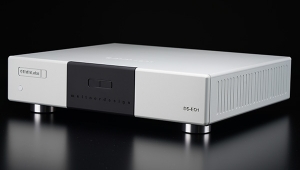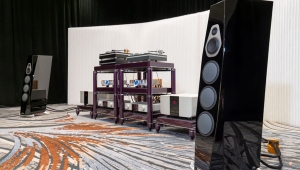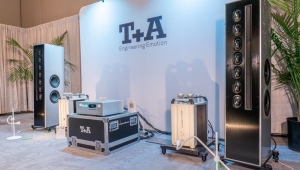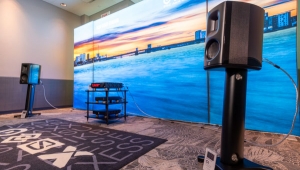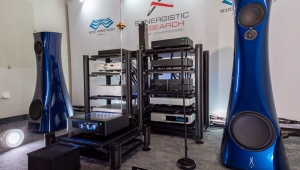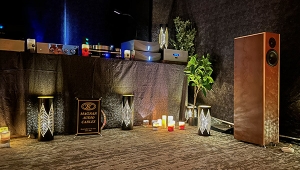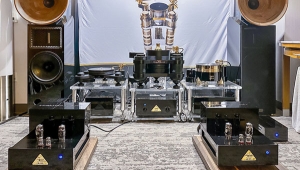| Columns Retired Columns & Blogs |
Wilson Audio WATT/Puppy System 5 loudspeaker Page 2
The single pair of speaker connections is a nonstandard type manufactured by WBT. Wilson claims that of all the hardware the company has tested, these sound the best. I believe this in the superstitious way that I believe that nasty-tasting medicine does the best job—I hated them, finding them difficult to use, and impossible to tighten to the point where my cat couldn't dislodge the connection just by stepping on the cables. Of the crossover, the company will reveal only that the finest-grade components are used, that the slopes are matched to achieve acoustical phase linearity, and that the low-frequency tuning employs a quasi-third-order Butterworth response.
The Puppy looks more like an ordinary box. It's 12" wide by 16.5" deep—a match for the WATT's footprint—which makes sense, since it's designed to serve as a stand for the monitors. Its 39" height is, not coincidentally, the ideal stand height for the WATT. The Puppy sports two 8" Dynaudio woofers constructed upon massive motor units (2" voice-coils!). The rear-firing ported enclosure is constructed to the same degree of rigidity as the WATT, and features extensive asymmetrical cross-bracing and internal tuning to control resonant spuriae. There are two sets of those verklemmt WBT connectors, and—
Maybe I need to talk about this for a second. David Wilson doesn't design the WATT/Puppy system to be bi-amplified; he claims it won't improve performance and, God knows, at 93dB sensitivity, the system doesn't require a brace of amps. The two sets of connectors on the Puppy consist of one pair for input from your amplifier and another to connect the Puppy Tail (hey, don't blame me, I'm just reporting this)—a specially spec'd run of MIT speaker cable—to the WATT through an internal channel on the Puppy. The Puppy has threaded inserts that accept the Puppy Paws (see preceding parenthetic remark): massive cones designed to couple the Puppy to the floor.
I asked David Wilson about the Paws, since earlier iterations of the speaker employed more-typical spiking hardware. "They do more effectively couple the Puppy to the floor, but also serve as a response to two factors," he said. "Number one, a lot of people have asked for a way to slightly raise the soundstage. The height of the system—the distance between the acoustical center at any given frequency and the floor—is critical in that it affects the comb-filter response of the system when you're listening in a room. We established that to be acceptable in the widest range of rooms possible, so you don't want to haphazardly change those dimensional relationships. The Puppy Paws allow a degree of fine-tuning to that relationship, affecting soundstage height and, subtly, upper-bass/lower-midrange energy from the system. By extending the Puppy Paws to their maximum, you can lean out the response in those regions—some rooms, especially those made out of reinforced concrete, trap a lot of energy. This helps to resolve that problem."
I can attest that this works in practice, as I moved to New Mexico in the midst of doing my critical listening for this report. My old room, which had lathe and plaster walls, proved articulate and balanced with the standard Puppy Paws. My new room has plastered Sheetrock walls covered on the outside with a rigid skin of fake adobe, and the speakers manifested a lower-region boom that obscured all of the lovely inner voicing on my favorite discs. As I tried to organize my office—a project that I figure to complete just in time for my next move—I came across the additional spacers, and a light bulb illuminated the thought-balloon over my head. Hmmm, could it be? Yes, it could—balance was restored, and I was able to enjoy my music.
There's one last element of the WATT/Puppy system: the three bituminous discs that serve as the interface between the two enclosures. Wilson Audio claims that removing or changing these pads for some other material will change the voicing of the speakers. I can't attest to that, as I only used the pads supplied—but I did find that they wandered. After weeks of listening, I would find the WATTs migrating off the Puppys, hanging over one side or the other. It's a simple matter to realign the WATTs, but I suspect that it's also a simple matter to prevent this from happening in the first place. (Mark Goldman, Wilson's national sales manager, suggests that my Puppys weren't level, but my spirit level disagrees with him.)
Watt's the story?
Setting up the WATT/Puppys is an interesting process. Mark Goldman came to my house to introduce me to Wilson Audio's system of "voweling-in" a speaker to the room in which it is located (see sidebar). Wilson's dealers perform this service for any consumers purchasing the system. The point of the exercise is to remove the room from the equation, leaving the listener exposed to as much of the directly radiated sound as possible. The result was that the speakers were farther apart and nearer the rear walls than any other high-performance speaker I've experienced. My listening position was also pulled closer to the center of the room. Coupled with the WATT/Puppy's modest footprint, this means that in an average room the System 5 is about as unobtrusive as high-end speakers get—no more speakers in the middle of the floor!
- Log in or register to post comments
















